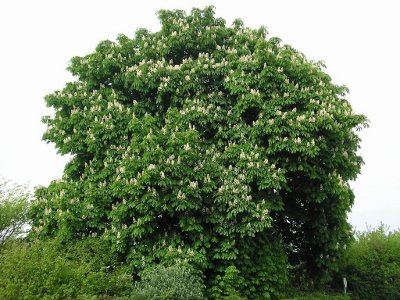Horsechestnut (Aesculus hippocastanum)
Category: Fruit & Nut Trees

Horsechestnut is a deciduous tree that hails from the small area in the Balkan mixed forests and Pindus Mountains mixed forests of the Southeastern part of Europe. The bark of the tree exfoliates on older samples, revealing orange colored bark underneath. This is a large flowering tree and ornamental tree that has an average growth rate, and grows well in full sun and in partial shadow. The Horsechestnut tree grows well in all kinds of soils, such as acidic, moist, loamy, sandy, rich, silty loam, clay and well drained soils. This tree with wide branches attains the oval, rounded shape when fully grown, with lower branches suspending down.
Features
The Horsechestnut shade tree is capable of growing to a height that ranges from 50 feet to 75 feet, with widespread branches that spread to a range from 40 feet to 70 feet.
The leaves of the tree are opposite and palmately compound, and they appear with 5 leaflets to 7 leaflets, with the length that ranges from 13 cm to 30 cm. The leaves of the tree are green in color as they open out, emerging with dark green in color when fully grown.
The Horsechestnut tree produces flowers in the spring season, and they are usually white in color, with a tiny red spot. These flowers found in vertical panicles, with the height that ranges from 10 cm to 30 cm, with 20 to 50 flowers on each panicle.
Usually, each panicle of the Horsechestnut tree produces a maximum of five fruits, with the green-colored shell with the diameter, ranging from 2 cm to 4 cm. The brown-colored nuts of the tree are glossy, with a whitish mark at the bottom.
Uses
The nuts of the Horsechestnut tree, particularly those that are fresh and young, are consumed by horses, including other mammals, such as deer. The extract of the seed of the tree is used due to its venotonic effect, has anti-inflammatory, vascular protection and free radical scavenging features.
The average lifespan of the Horsechestnut tree is more than 60 years.

 Back To Category Fruit & Nut Trees
Back To Category Fruit & Nut Trees